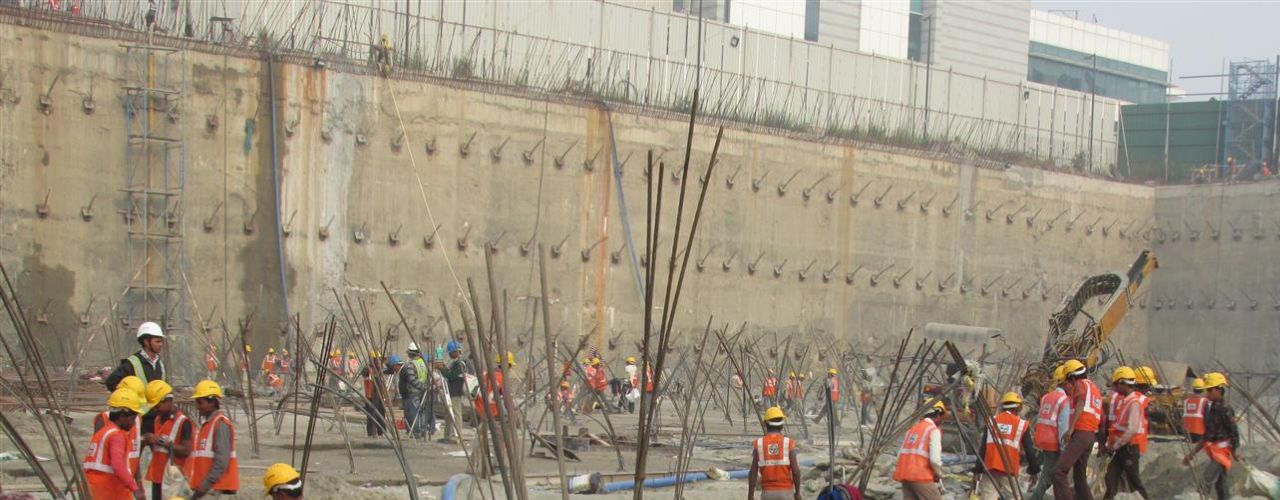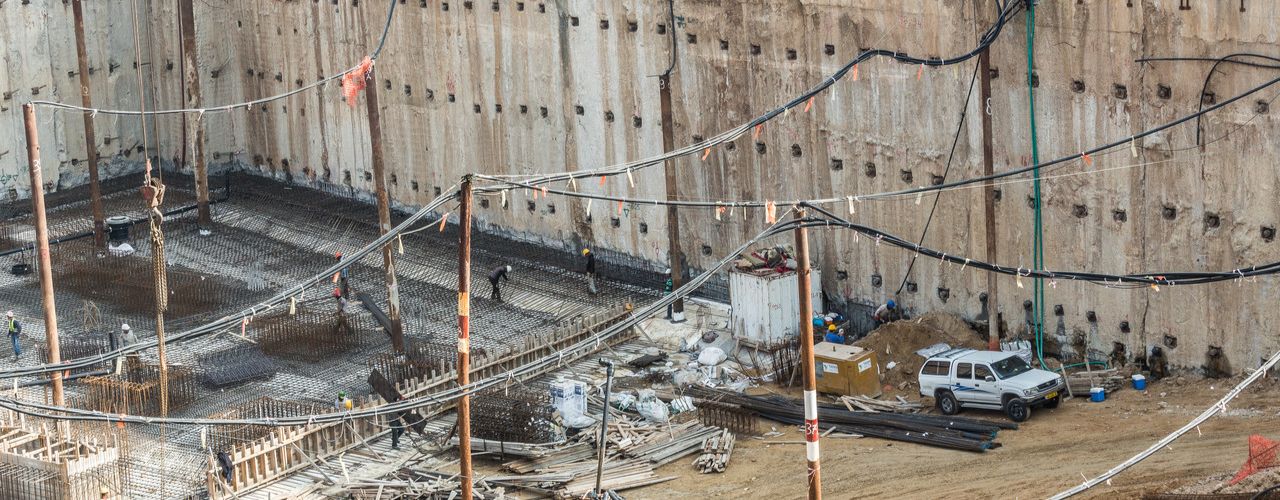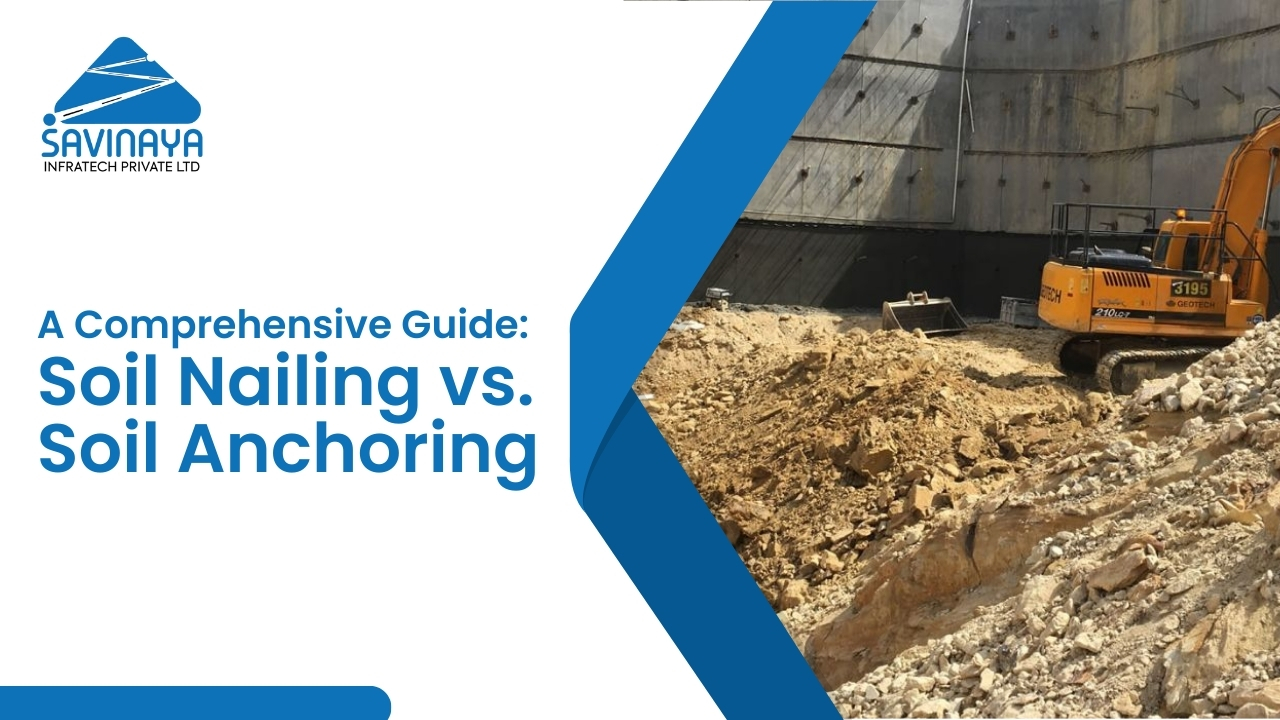
SOIL ANCHORING
ISO 9001:2005 Certified


Soil Anchoring is a technique that includes fitting steel bars through holes drilled in the shoring wall such as sheet piles to anchor the wall to a stable zone. Soil anchoring improves slope stability and prevents it from collapsing. Additionally, it is used to provide structural support to the sidewalls of the launch and exit pits during the construction stage.
Advantages of Soil Anchoring
At Savinaya, we use state-of-the-art equipment and techniques to provide reliable and cost-effective soil anchoring solutions that meet your specific needs. Our team works closely with you to understand your project requirements and provide customised solutions that ensure the safety and stability of your structures. With our commitment to quality, safety, and customer satisfaction, you can trust us to deliver exceptional results for all your soil anchoring needs.
- Stability: Soil anchoring provides stability to structures such as retaining walls, bridge abutments, and slopes by reducing soil movement and preventing erosion.
- Durability: Soil anchors are highly durable and can withstand harsh weather conditions and natural disasters.
- Cost-Effective: Soil anchoring is generally a cost-effective solution compared to other stabilisation methods like excavation or replacement of damaged structures.
- Customizable: Soil anchoring can be customised to meet specific project needs, including the type of anchor used and the depth and angle of installation.
- Minimal Disruption: Soil anchoring is a non-intrusive method that can be installed with minimal disruption to the surrounding environment and structures.
FAQs
Ground anchors are structural elements used to secure and stabilize retaining walls, slopes, or other structures. The process involves drilling into the ground, inserting an anchor rod, and then applying tension to the anchor to hold the structure in place. The anchor is typically installed with a grout or resin to provide stability and durability.
Soil anchoring involves the installation of soil anchors that are tensioned to provide support to structures like retaining walls or slopes. Soil nailing, on the other hand, involves the insertion of reinforcement bars (nails) into the soil, which are then grouted to stabilize the soil.
The key difference is that soil anchoring is primarily used for tension-based support, while soil nailing is more focused on reinforcing the soil structure.
Ground anchors are designed to last for decades. Their durability depends on the soil conditions, the materials used in the anchor, and the environmental conditions. Typically, with proper maintenance, ground anchors can last 30 to 50 years or even longer.
Soil anchors work by transferring tensile forces into the surrounding soil. The anchor is installed into the ground, and then tension is applied to it, which stabilizes structures like retaining walls or slopes by counteracting the forces acting against the soil or structure.
There are several methods of soil anchoring, including the use of tie-back anchors, soil nails, and rock bolts. These methods involve installing anchors into the soil or rock mass, which are then tensioned or grouted to provide stability to retaining walls or slopes.
If your project involves building a retaining wall, stabilizing slopes, or dealing with unstable soil conditions, it may require soil anchoring. A geotechnical engineer can assess the soil conditions and the load requirements to determine if soil anchoring is necessary for your project.
There are several types of soil anchors available, including grouted anchors, mechanical anchors, and helical anchors. The choice of anchor depends on the soil conditions, the load requirements, and the specific needs of the project.
Yes, soil anchoring is environmentally friendly as it uses minimal materials compared to other stabilization methods. It also reduces the need for large-scale excavation and can be used in sensitive or restricted sites, minimizing the environmental impact.
The design of a soil anchoring system is influenced by several factors, including soil type, groundwater conditions, load requirements, the type of structure being supported, and environmental conditions. These factors determine the type and size of soil anchors used in the system.
The ground anchor technique involves drilling holes into the ground, inserting anchor rods or cables, and applying tension to stabilize a structure. The technique is commonly used to reinforce retaining walls, foundations, and slopes, providing a reliable method of soil stabilization.
The best ground for soil anchoring is firm, stable soil with good load-bearing capacity. Clay, sandy, and gravelly soils are typically ideal for soil anchoring. However, the suitability of the ground will depend on the specific conditions of the site and the type of soil anchor used.
Soil anchoring is effective in a variety of soil conditions, including sandy, clayey, and gravelly soils. However, the stability of the ground, the moisture content, and the load-bearing capacity must be considered when selecting the appropriate soil anchor system. In some cases, rock or deep soil may also be suitable for soil anchoring.


